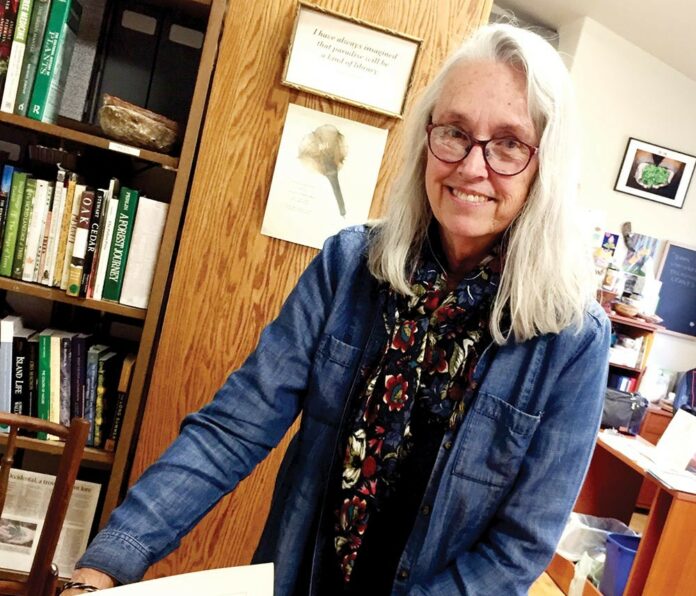Tucked away at the downtown Occidental Art Center, the Botanical Dimensions Ethnobotany Library is a surprising, rare jewel featuring a collection of over a thousand books.
Many are rare or hard-to-find and are about plants, indigenous cultures, psychedelics, mycology, mythology, cultural anthropology, herbalism, ritual, shamanism, healing, art and more. The study of ethnobotany looks at the relationship between plants, humans and fungi over time and between cultures and therefore involves many interconnected subjects.
At a time when even used bookstores are hard to find, one can walk into this quiet, magical world of unusual books, make a cup of tea and read all afternoon. Library members have access to the lending shelves, members’ events and special discounts on a range of unique classes, including Global Ethnobotany or Cannabis and Spirituality: An Explorer’s Guide to an Ancient Plant Ally.
Kathleen Harrison and Terence McKenna founded Botanical Dimensions (BD) in 1985, and Harrison established the Ethnobotany Library in November 2015. BD’s original mission was to collect, protect, propagate and understand plants of ethnomedical significance and their lore.
“We do all that and more,” Harrison, an ethnobotanist, teacher, artist and writer, says. “We work to preserve biodiversity, respecting natural ecosystems and traditions of ecological knowledge. We appreciate, study and educate others about plants and mushrooms that are felt to be significant to cultural integrity and spiritual well-being.”
Besides the library, BD implements other plant-focused educational programs, including the Mazatec Project in Mexico, the Amazon Herbarium Project in Peru and the Forest-Garden in Hawaii. The latest project with Harrison’s daughter, photographer Klea McKenna, is a film called Almost Visible about a multi-generational, decades-long relationship between Harrison and McKenna’s family and a Mazatec clan in Mexico. There is currently an end-of-year Giving Campaign underway on their website to raise funds for the library and educational programs.
The library reflects Harrison’s unified perspective and comes from her own personal collection, curated over the years. She accumulated a huge collection of books—including many rare titles—during her decades of study and travel.
“I had way too many books,” she laughs. “I’ve always bought used books; if I’m interested in something I buy books about it.”
Five years ago she decided to thin her collection, so she distributed a few boxes of books to her students at the California School of Herbal Studies, where she’s taught an annual, day-long ethnobotany class for the past 20 years. While Harrison was grateful that her plant books went to appreciative, budding herbalists, she wondered if the rest of the collection might benefit more people if it were grouped together and made publically accessible.
“My book collection is my worldview,” she says. “It’s a 360-degree view of the plant-human-fungal matrix and I decided to keep it all together. Because it represents an inquisitive, full-circle way of seeing the world.”
Harrison is unusually well-integrated. While part of the library reflects her work with psychedelic plants, she respects all aspects of the cultures that use them. Though she never shies away from the topics of ayahuasca or “magic” mushrooms, she places as much importance on plants involved in basket-weaving or cordage as she does on plants involved in shamanic ceremonies.
“I brought over 1,000 books to start the library,” Harrison says. “I also brought art, objects and artifacts. When I teach, I ransack my house for objects, and some of them end up staying here.”
Over the course of the past 20 years, Harrison took hundreds of students on ethnobotany field trips to Hawaii, Mexico, Ecuador and the Peruvian Amazon. Nowadays, she teaches close to home in Occidental.
“It was intense to take a lot of college kids to the Peruvian Amazon,” she says. “I got tired of traveling so much.”
The library includes an adjoining 40-person classroom where she and others teach a variety of unique classes. Her teaching style is conversational and flows with the group in attendance. Classes range from Botanical Illustration to Psychedelic Plants: An Introduction to the Biology and Ritual Ethnobotany of Peyote, Tobacco and Ayahuasca.
“Once you get into worldview you have a lot of branches to follow,” she says, pulling out a book called Translated Woman by Ruth Behar. “There’s mythology, nature, spirituality—even writers about animism here.”
Her own writing can be found in the new book Psychedelic Mystery of the Feminine edited by Maria Papaspyrou, Chiara Baldini, David Luke and Allyson Grey.
“All our work protects and distributes knowledge about plants, cultures and how they weave together over time,” Harrison says. “It’s always evolving and changing. The library represents the many aspects of the ever-evolving, complex relationship between humanity and the plant-fungal world.”











